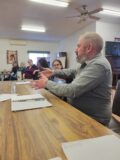Commentary
Common sense evolution
January 17, 2023

By Nate Smelle
As with every cliché, there is a good reason why it is so frequently employed. That being its accuracy in describing a common occurrence. For instance, it is often said that “time flies when we’re having fun.” Although if used out of context a cliché such as this might not fit the given circumstances, standing on its own, it always holds true.
It has now been more than three years since COVID-19 changed the game. During this historic time period, several irrefutable truths came into light which must not be ignored. While there are too many to go over each one individually here, there is one that is especially pressing, which demands immediate attention – the fragile state of our health care system in Ontario.
Nowhere did the spotlight on this issue shine brighter than it did on Ontario’s long-term care system. As the first wave of the pandemic hit Ontario in March 2020, we quickly discovered how perilous the situation truly is for many of our Elders living in one of the 627 long-term care homes throughout the province. Of these 627 facilities: 16 per cent are publicly owned; 57 per cent are owned by private for-profit organizations; and, 27 per cent are owned by private not-for-profit organizations.
According to the Ontario Health Coalition, the COVID-19 pandemic exposed “horrific negligence in the for-profit homes compared to public and non-profit homes.”
In a report posted on the coalition’s website, it reveals that residents of for-profit facilities in Ontario are 60 per cent more likely to become infected with COVID-19, and 45 per cent more likely to die than residents living in non-profit homes. The report also indicates that the death rate in for-profit homes was also found to be five times greater than those of publicly-owned homes, and double those of non-profits. Furthermore, residents of for-profit facilities were also shown to be at higher risk of being hospitalized with pneumonia, anemia, and dehydration than those in publicly owned or non-profit homes.
For those committed to the big lie that greed and unregulated free markets contribute to the common good, I could see how destroying a publicly-owned institution such as Ontario‘s health care system might appear to be a good idea. However, for those of us living in the real world, the only individuals who benefit from such a foolish idea are those with enough money to buy one of the many “fixer upper” hospitals or long-term care homes in Ontario.
Money is not the only thing required to buy into the privatization of our health care system. One must also possess a strong propensity for greed and violence, as well as a seasoned ability to willfully remain ignorant when the opportunity to make a buck by taking advantage of others arises.
With this precise combination of cash, ignorance, and indifference at heart and in mind back in 1995, Ontario’s former regressive Conservative premier Mike Harris launched his government’s so-called “Common Sense Revolution.” As part of Harris’s ironically irrational revolt against the common good, his government was responsible for: cutting social assistance rates by nearly 22 per cent; a series of hospital closures and amalgamations throughout the province; the sale of critical publicly-owned assets such as Ontario Hydro and Highway 407; and, the privatization of home care, long-term care, and provincial water testing in 1996, which eventually led to the poisoning of more than 100 people and the death of seven in Walkerton nearly four years later.
After leaving office, former premier Harris began serving as chair of the board for Chartwell Retirement Residences—one of the privately-owned long-term care facilities in the province, now providing “health care” for-profit.
Amid the first wave of the pandemic in May of 2020, The Toronto Star published an article indicating that Chartwell, one of the three largest for-profit long-term-care providers in Ontario, that had “disproportionately high numbers of COVID-19 cases and deaths.” At the time it was also reported that in the 10 years leading up to the pandemic Chartwell paid out some $1.5-billion in dividends to its shareholders.
In January 2021 The Globe and Mail published another article entitled, “Golden years, golden boards: Mike Harris’s post-politics career.” In this piece by The Globe’s David Milstead, it is reported that since he joined the board at Chartwell, Harris has received about $3.5-million in compensation for his services.
“It’s an average of roughly $200,000 a year for what is supposed to be a part-time job,” explained Milstead.
Think about that … $200,000 a year for part-time work, while residents are receiving sub-standard “health care.”
As chief Twit tech billionaire Elon Musk would say, “Let that sink in!”
One doesn’t need to polish their spectacles to see that none of these decisions were in the interest of the common good.
Nevertheless, there is no good that comes from dwelling in the past. And that’s where Harris’s “Common Sense Revolution” must stay. Now, despite being fully aware of the fact that the lives of thousands of Elders could have been saved if profit was removed from health care in Ontario, our current PC premier in Ontario Doug Ford is attempting to move forward with the privatization of certain services already provided through our public health care system.
Thinking about the state of our health care system in Ontario, and the evolution of common sense that is needed to occur if we are going to prevent it from being stolen from us, there is another cliché that comes to mind: “All for one and one for all!”
If we embrace this mindset instead of one based in greed, indifference, and willful ignorance, we will be just fine.


















